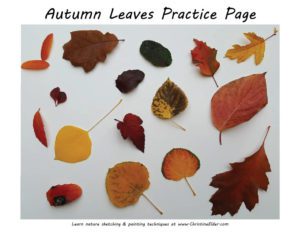
>>CLICK HERE TO WATCH EVENT<<
With Autumn in full swing here in central Oregon where the sagebrush meets the pines, join me for a fun, casual leaf painting activity.
I’ll be live on November 7th (noon – 1pm PST) on my YouTube Channel. You can simply watch or follow along by gathering some of your own Autumn leaves and paint supplies.
Download these resources below
General Painting Steps
- Assemble your art supplies including watercolors, brush, pencil and paper.
- Collect a variety of colorful leaves. If you can’t pick any of your own leaves, you can download the resources listed above.
- Sketch a leaf or save time by simply tracing a leaf onto your paper.
- Take some time to observe your leaf before you start painting. Notice and name the colors you see and how they blend together.
- Paint loosely in a wet-in-wet technique starting by wetting the leaf you’ve outlined on your paper with clear water.
- While your paper is still wet, paint the lightest color in your leaf , then quickly add darker ones, such as in this order: yellow, green, orange, sienna, blue.
- Be bolder with your colors than you think you should, since watercolors always dry paler than they look when wet.
- Don’t get too fussy or perfectionist by overworking the paints on your paper, just quickly drop colors in and move on, or else you risk over-mixing the colors and making mud!
- Let painting dry then feel free to add emphasis with additional layers of watercolor, pencil, pen, or opaque white gelly roller pens.
- Most importantly, have fun! I always encourage my students to enjoy the process over the product and progress over perfection!
Want to learn more about drawing and painting plants?
Does the thought of painting in watercolor intimidate you? Is it even harder for you to imagine how you might do it outdoors, in a park or meadow? Let me help get you started! Fall leaves are a great subject to start your painting journey with, since they come in so many different colors which softly blend together making painting a breeze. As wise folks like Confucius, Shakespeare, and Voltaire have said, in one form or another, “perfect is the enemy of the good”.
If you enjoyed this tutorial I bet you’d love my comprehensive course on botany. It includes videos and downloadable guides that you can study in the comfort of your own home. Learn more about my Colorful Botanicals course HERE.


